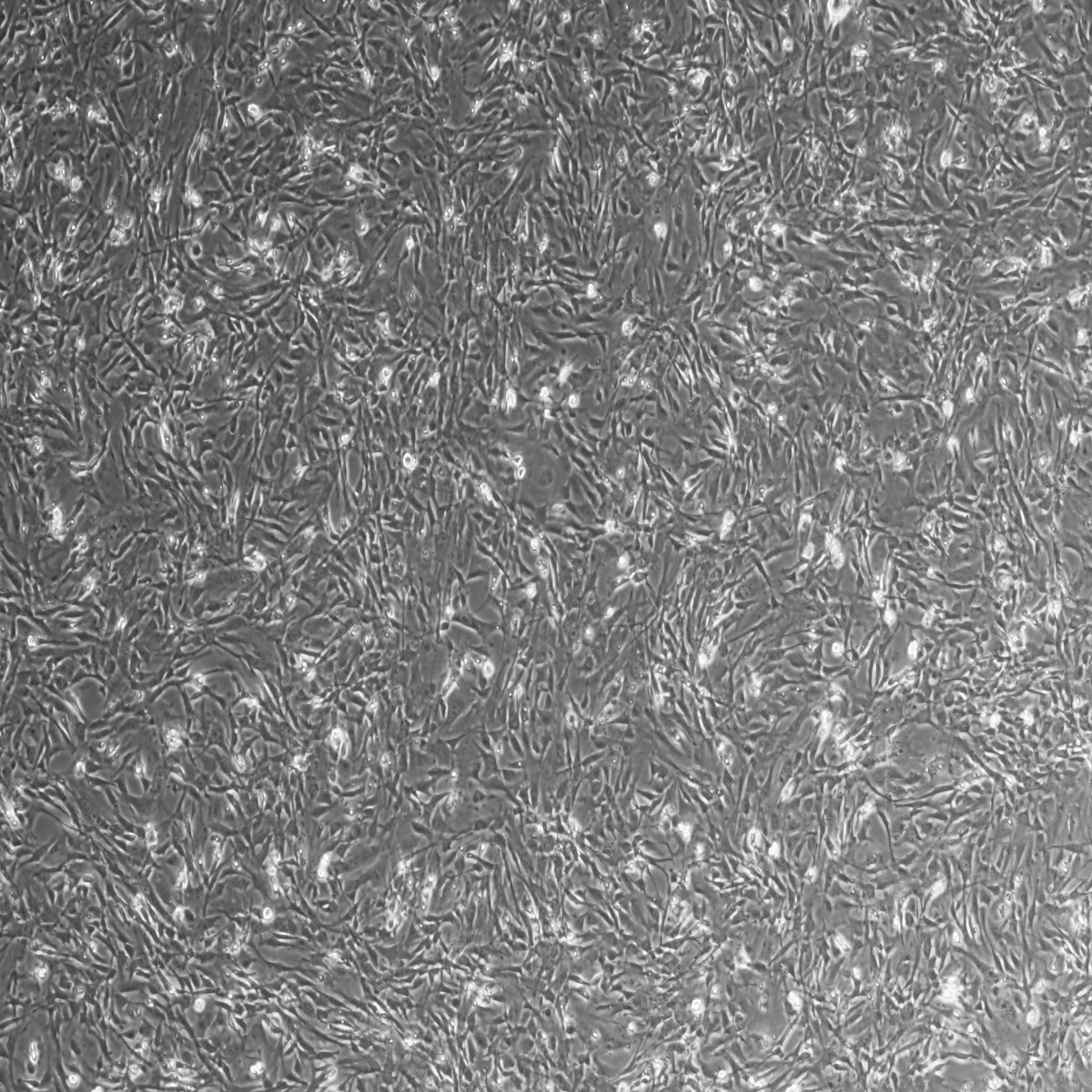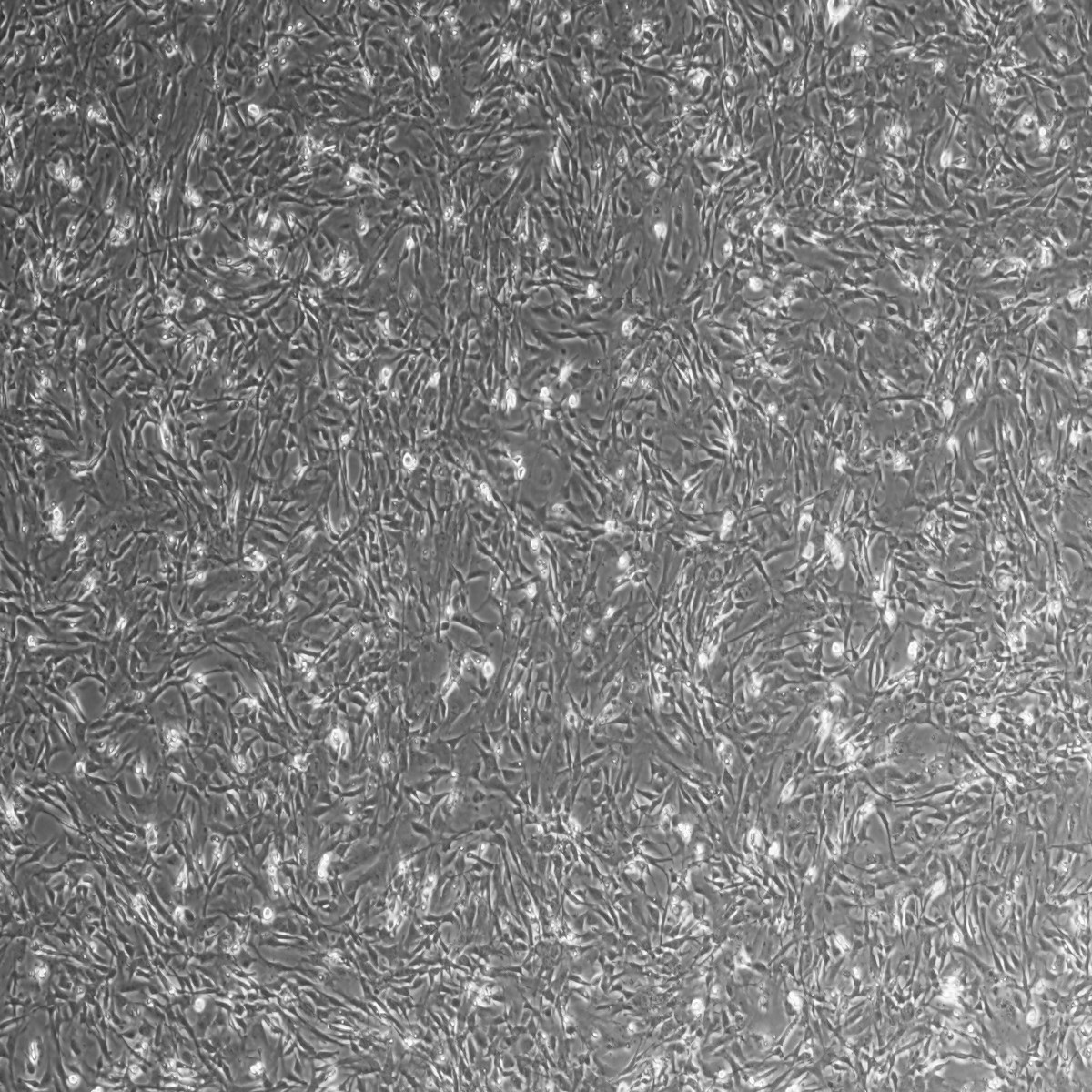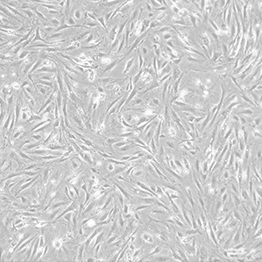MEFs
Feeder Cells for Pluripotent Stem Cell Cultures: Functions, Limitations, and Alternatives
Mouse embryonic feeder cells (MEFs), often referred to simply as feeder cells, are a type of supportive cell layer derived from mouse embryos. They are commonly used in the culture of pluripotent stem cells, including embryonic stem cells (ESCs) and induced pluripotent stem cells (iPSCs).
Feeder cells serve several important functions in stem cell culture
- Support: Feeder cells provide a supportive environment for the growth and maintenance of pluripotent stem cells. They secrete various factors and provide physical support that helps stem cells remain undifferentiated and proliferative.
Nutrient Supply: Feeder cells supply essential nutrients to the stem cells, promoting their growth and survival in culture. This includes growth factors, cytokines, and other signaling molecules that regulate stem cell behavior. - Inhibition of Differentiation: Feeder cells produce factors that inhibit the spontaneous differentiation of pluripotent stem cells. This helps maintain the stem cell population in an undifferentiated state, preserving their ability to differentiate into various cell types when directed.
- Adhesion: Feeder cells form a substrate to which pluripotent stem cells can adhere. This anchorage promotes cell-cell interactions and provides stability to the culture, preventing stem cells from detaching and undergoing apoptosis.
Feeder cells are typically derived from mouse embryonic fibroblasts (MEFs) obtained from the inner cell mass of early mouse embryos. These cells are cultured and treated to prevent them from dividing, ensuring that they provide a stable support layer without overgrowing the stem cell culture.
We have MEF feeder cells available:
CF-1, DR4, neo-resistent, and SNL 76/7 (STO Line)
Moving Beyond Feeder Cells: Advancements in Pluripotent Stem Cell Culture
During the last decades it was realized that the use of feeder cells has some limitations and drawbacks, including the risk of contamination with mouse pathogens and the potential for variability between batches. As a result, in addition feeder-free culture systems and synthetic substrates have been developed as alternatives for stem cell culture, offering more defined and reproducible conditions for stem cell expansion and differentiation.
-
CF-1 MEF, P2, untreated
Cat.-Nr: ASF-1201
CF-1 MEF Feeder Cells, P2, untreated, are derived from CF-1 mouse embryos and used as feeder layers to support the growth of undifferentiated mouse... Read More
-
CF-1 MEF, P2, untreated
Cat.-Nr: ASF-1202
CF-1 MEF Feeder Cells, P2, untreated, are derived from CF-1 mouse embryos and used as feeder layers to support the growth of undifferentiated mouse... Read More
-
CF-1 MEF, P3, irradiated
Cat.-Nr: ASF-1213
CF-1 MEF Feeder Cells, P3, irradiated, are derived from CF-1 mouse embryos and used as feeder layers to support the growth of undifferentiated mouse... Read More
-
CF-1 MEF, P3, irradiated
Cat.-Nr: ASF-1214
CF-1 MEF Feeder Cells, P3, irradiated, are derived from CF-1 mouse embryos and used as feeder layers to support the growth of undifferentiated mouse... Read More
-
CF-1 MEF, P3, irradiated
Cat.-Nr: ASF-1215
CF-1 MEF Feeder Cells, P3, irradiated, are derived from CF-1 mouse embryos and used as feeder layers to support the growth of undifferentiated mouse... Read More
-
CF-1 MEF, P3, irradiated
Cat.-Nr: ASF-1216
CF-1 MEF Feeder Cells, P3, irradiated, are derived from CF-1 mouse embryos and used as feeder layers to support the growth of undifferentiated mouse... Read More
-
CF-1 MEF, P3, irradiated
Cat.-Nr: ASF-1217
CF-1 MEF Feeder Cells, P3, irradiated, are derived from CF-1 mouse embryos and used as feeder layers to support the growth of undifferentiated mouse... Read More
-
CF-1 MEF, P3, Mitomycin C Treated
Cat.-Nr: ASF-1223
CF-1 MEF Feeder Cells, P3, mitomycin-C treated, are derived from CF-1 mouse embryos and used as feeder layers to support the growth of... Read More
-
CF-1 MEF, P3, Mitomycin C Treated
Cat.-Nr: ASF-1224
CF-1 MEF Feeder Cells, P3, mitomycin-C treated, are derived from CF-1 mouse embryos and used as feeder layers to support the growth of... Read More
-
CF-1 MEF, P3, Mitomycin C Treated
Cat.-Nr: ASF-1225
CF-1 MEF Feeder Cells, P3, mitomycin-C treated, are derived from CF-1 mouse embryos and used as feeder layers to support the growth of... Read More
-
CF-1 MEF, P3, Mitomycin C Treated
Cat.-Nr: ASF-1226
CF-1 MEF Feeder Cells, P3, mitomycin-C treated, are derived from CF-1 mouse embryos and used as feeder layers to support the growth of... Read More
-
DR4 MEF Feeder Cells, P3, Mitomycin C Treated
Cat.-Nr: ASF-1023
DR4 MEF Feeder Cells, P3, Mitomycin C-treated (MMC), are derived from DR4 mouse embryos and used as feeder layers to support the growth of... Read More
-
DR4 MEF Feeder Cells, P3, Mitomycin C Treated
Cat.-Nr: ASF-1024
DR4 MEF Feeder Cells, P3, Mitomycin C-treated (MMC), are derived from DR4 mouse embryos and used as feeder layers to support the growth of... Read More
-
DR4 MEF Feeder Cells, P3, Mitomycin C Treated
Cat.-Nr: ASF-1025
DR4 MEF Feeder Cells, P3, Mitomycin C-treated (MMC), are derived from DR4 mouse embryos and used as feeder layers to support the growth of... Read More
-
DR4 MEF Feeder Cells, P3, Mitomycin C Treated
Cat.-Nr: ASF-1026
DR4 MEF Feeder Cells, P3, Mitomycin C-treated (MMC), are derived from DR4 mouse embryos and used as feeder layers to support the growth of... Read More
-
DR4 MEF, P2, untreated
Cat.-Nr: ASF-1001
DR4 MEF Feeder Cells, P2, untreated, are derived from DR4 mouse embryos and used as feeder layers to support the growth of undifferentiated mouse or... Read More
-
DR4 MEF, P2, untreated
Cat.-Nr: ASF-1002
DR4 MEF Feeder Cells, P2, untreated, are derived from DR4 mouse embryos and used as feeder layers to support the growth of undifferentiated mouse or... Read More
-
DR4 MEF, P3, irradiated
Cat.-Nr: ASF-1013
DR4 MEF Feeder Cells, P3, irradiated, are derived from DR4 mouse embryos and used as feeder layers to support the growth of undifferentiated mouse or... Read More
-
DR4 MEF, P3, irradiated
Cat.-Nr: ASF-1014
DR4 MEF Feeder Cells, P3, irradiated, are derived from DR4 mouse embryos and used as feeder layers to support the growth of undifferentiated mouse or... Read More
-
DR4 MEF, P3, irradiated
Cat.-Nr: ASF-1015
DR4 MEF Feeder Cells, P3, irradiated, are derived from DR4 mouse embryos and used as feeder layers to support the growth of undifferentiated mouse or... Read More
-
DR4 MEF, P3, irradiated
Cat.-Nr: ASF-1016
DR4 MEF Feeder Cells, P3, irradiated, are derived from DR4 mouse embryos and used as feeder layers to support the growth of undifferentiated mouse or... Read More
-
Neo-resistant MEF Feeder Cells, P3, Mitomycin C Treated
Cat.-Nr: ASF-1126
Neo-resistant MEF Feeder Cells, P3, Mitomycin-C (MMC), are derived from mouse embryos and are resistant to neomycin. These are used as feeder layers... Read More
-
Neo-resistant MEF Feeder Cells, P3, Mitomycin C Treated
Cat.-Nr: ASF-1123
Neo-resistant MEF Feeder Cells, P3, Mitomycin-C (MMC), are derived from mouse embryos and are resistant to neomycin. These are used as feeder layers... Read More
-
Neo-resistant MEF Feeder Cells, P3, Mitomycin C Treated
Cat.-Nr: ASF-1125
Neo-resistant MEF Feeder Cells, P3, Mitomycin-C (MMC), are derived from mouse embryos and are resistant to neomycin. These are used as feeder layers... Read More
-
Neo-resistant MEF, P2, untreated
Cat.-Nr: ASF-1101
Neo-resistant MEF Feeder Cells, P2, untreated, are derived from mouse embryos and are resistant to neomycin. These are used as feeder layers to... Read More
-
Neo-resistant MEF, P2, untreated
Cat.-Nr: ASF-1102
Neo-resistant MEF Feeder Cells, P2, untreated, are derived from mouse embryos and are resistant to neomycin. These are used as feeder layers to... Read More
-
Neo-resistant MEF, P3, irradiated
Cat.-Nr: ASF-1113
Neo-resistant MEF Feeder Cells, P3, irradiated, are derived from mouse embryos and are resistant to neomycin. These are used as feeder layers to... Read More
-
Neo-resistant MEF, P3, irradiated
Cat.-Nr: ASF-1114
Neo-resistant MEF Feeder Cells, P3, irradiated, are derived from mouse embryos and are resistant to neomycin. These are used as feeder layers to... Read More
-
Neo-resistant MEF, P3, irradiated
Cat.-Nr: ASF-1115
Neo-resistant MEF Feeder Cells, P3, irradiated, are derived from mouse embryos and are resistant to neomycin. These are used as feeder layers to... Read More
-
Neo-resistant MEF, P3, irradiated
Cat.-Nr: ASF-1116
Neo-resistant MEF Feeder Cells, P3, irradiated, are derived from mouse embryos and are resistant to neomycin. These are used as feeder layers to... Read More
-
Neo-resistant MEF, P3, Mitomycin C Treated
Cat.-Nr: ASF-1124
Neo-resistant MEF Feeder Cells, P3, Mitomycin-C (MMC), are derived from mouse embryos and are resistant to neomycin. These are used as feeder layers... Read More
-
SNL 76/7 feeders, STO cell line, P12, untreated
Cat.-Nr: ASF-1305
Mouse embryonic stem cells (ESCs) and induce pluripotent stem cells (iPSCs) generally require culture on feeder cells as well as medium containing... Read More
-
SNL Feeder Cells 76/7 Mouse Fibroblast STO Cell Line, P14, Mitomycin C Treated
Cat.-Nr: ASF-1327
Mouse embryonic stem cells (ESCs) and induced pluripotent stem cells (iPSCs) generally require culture on feeder cells as well as medium... Read More




